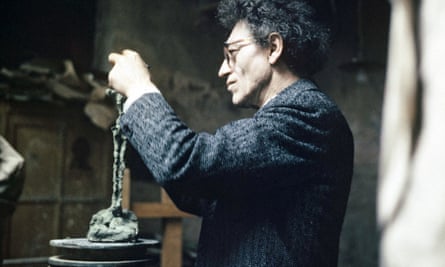Sometimes a hunch pays off, and when the English painter John Craxton recognised a work of genius for sale in a London antiques shop, he made very much the right call.
Craxton parted with £250 for an unusual chandelier he suspected was by the great sculptor Alberto Giacometti. Now that chandelier, made in the late 1940s, may sell at Christie’s in a few weeks’ time for many millions. Pieces by the revered Swiss artist are the most expensive sculptures to buy at auction, and his work regularly breaks saleroom records.
The chandelier has an estimated price of £1.5m – £2.5m (plus the buyer’s premium), but Michelle McMullan at Christie’s recognises this is a conservative baseline for such a “prestigious” chandelier that is “extremely rare”. “The market for Alberto and his brother Diego Giacometti design pieces has never been stronger, with the top price for a Giacometti chandelier at auction being £7,602,400 in 2018 for a bronze from 1949,” she said..
When Craxton first spotted the unique light fitting in a shop on Marylebone Road in the 1960s, he believed it had been commissioned by his late friend, the art collector Peter Watson. Confident about his purchase, Craxton – who died in 2009 – hung it in his home in Hampstead, north London, for 50 years, content to reflect on the piece’s extraordinary place in cultural history.
Aside from its aesthetic value, the chandelier once graced the lobby of the Bloomsbury offices of Horizon magazine, the cultural journal, now defunct, which was set up by Watson and Cyril Connolly in 1939 and went on to publish celebrated work by WH Auden, George Orwell, EM Forster and Dylan Thomas.

Watson, who had inherited a family fortune, built up an important collection of modern and surrealist art works while living in Paris. When he returned to London during the second world war, he switched to investing in British talents, such as Henry Moore, Lucian Freud and Craxton. He commissioned the chandelier from Giacometti during a return trip to Europe in 1946 or 1947.
In 2015, the authenticity of the chandelier was questioned in Britain, and the estate of John Craxton, which owns the piece, undertook a lengthy process to prove its provenance. London insurance broker Aston Lark was responsible for safely transporting the light to the Fondation Giacometti in Paris for verification in December 2021.
Julie Webb, private clients director for the broker, said: “It was a major security operation getting the chandelier to and from Paris but it was all worth the effort – the Chandelier for Peter Watson is now regarded as being among the most significant Alberto Giacometti hanging sculptures ever made as it features a suspended ball, in common only with his famous surrealist sculpture La Boule suspendue.”
after newsletter promotion
John Craxton’s biographer, Ian Collins, also a trustee of Craxton’s estate, said: “The Chandelier for Peter Watson displays the different streams of creative thinking that occupied Giacometti during this productive period.
“It was hung in the Bloomsbury offices of Horizon in 1949 but the magazine closed the following year. It was removed from the building and placed in storage, although we don’t know how it found its way to Denton’s antiques shop in Marylebone Road. It is likely that, along with other artworks from the offices, Watson gave them to Cyril Connolly, but the details may always remain a mystery.”
Art valuer James Glennie, of Art & Antiques Appraisals, worked with Aston Lark and Craxton’s estate throughout the valuation and authentication process and confirmed how exciting a bidding prospect the chandelier now is. “Alberto only created about half-a-dozen chandeliers,” he said, “but none of them have such a backstory, and so the Chandelier for Peter Watson should be thought of more as a sculpture than a light.”
